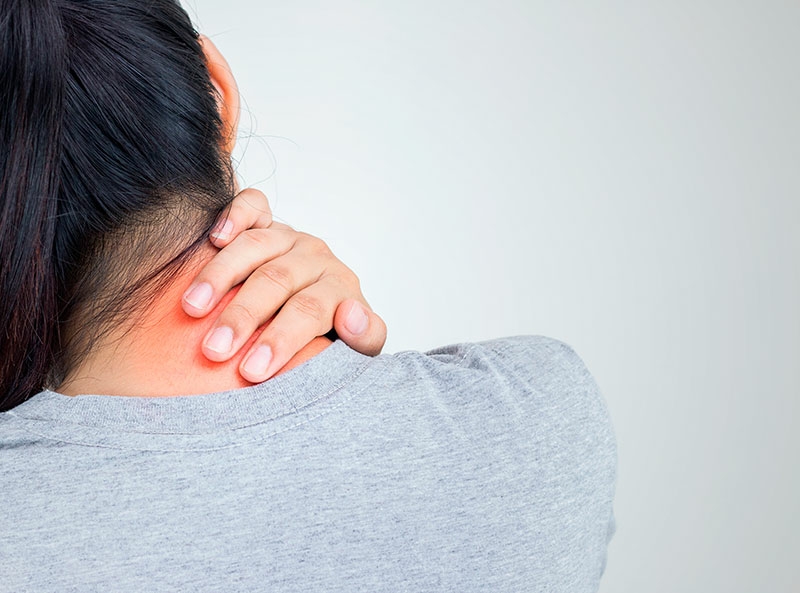Cervical Spondylosis is a chronic degenerative condition of the cervical spine that affects the vertebral bodies and intervertebral disks of the neck as well as contents of the spinal canal. It generally progresses with age and often develops at multiple interspaces. It is most commonly found in middle aged people but due to changes in lifestyle, this condition is becoming common in younger generation as well. People who are under exertion, frequent travellers can also end up with trauma on the neck bones. Bad posture is another strong etiological factor which results in stiffness due to spondylosis.

What are the symptoms of Cervical Spondylosis?
- Pain in the neck
- Pain that radiates to the shoulder, forearm or arm
- Numbness
- Difficulty in the usual functions of the neck such as rotation, flexion, extension etc.
- Tingling sensation and weakness in the arms
- Difficulty in walking or lack of co-ordination
Ayurvedic Concept of Cervical Spondylosis:
In Ayurveda, cervical spondylosis resembles Greeva Stambha, a disorder of Vata dosha. Greeva Stambha is one of the eight types of Vata Vyadhi. The symptoms of Vata Vyadhi include sankocha (contraction), shoola (pain), lomaharsha (horipulation), graham (spasticity) of back, handsm neck as well as head. Spandana (trembling of body), shosha (atrophy), gatrasuptata (numbness), bheda (breaking pain), toda (pricking pain), kampana (trembling), bala indriya bhramsa (loss of strength and sensory function) etc.
Griva Stambha comes under Nanatmaja Vata Vyadhi (various musculoskeletal and neurological disorders).
The samprapti (pathogenesis) of cervical spondylosis is mostly associated with the changes in the cervical vertebral column. There is a degeneration of inter-vertebral disc and the function of Shleshaka Kapha is affected. The function of shleshaka kapha is lubrication. Due to this, there is compression, irritation and inflammation in cervical regions which results in pain.
Some of the dietary habits that cause increase in vata dosha and contribute to cervical spondylosis include:
- Intake of dry, cold, frozen food
- Fasting for long periods also leads to depleted nourishment.
- Less intake of water.
- Excessive intake of junk food and cold drinks.
What is the treatment of Cervical Spondylosis according to Ayurveda?
In Ayurveda, the treatment options include snehana (oleation) and swedana (body heating) for Vata Vyadhi as described in shloka:

[Reference: Charak Samhita 28/81]
Meaning: The results of Snehana and Swedana are nourishment of dhatus (tissues), increase in agni-bala (strength of fire element) and ultimately increase in strength of the body.
Swedana (application of therapeutic heat) causes vasodilation, because of which blood circulation increases and there is a removal of catabolic waste i.e., lactic acid. As the blood circulation improves, anabolism increases as tissues receives the oxygen and nutrients.
Herbs that are useful in Cervical Spondylosis are:
- Ashwagandha (Withania somnifera): Ashwagandha is a potent Rasayana (immune-modulator) and acts as Brahmana (nourishes bones and muscles).
- Thus, it gives strength to the ligaments and muscles and also gives relief in pain associated with cervical spondylosis.
- It is useful in all types of dhatukashya (degeneration of body tissues).
- Chopchini (Smilax glabra): Chopchini possesses properties such as vedanahara (pain reliever), shothshamaka (subsides inflammation).
- This herb is very useful in vata vyadhi disorders like cervical spondylosis and it has the capacity to carry the drugs in suksham srotasa (micro-channels).
- So, it helps in decreasing pain and facilitation of drugs to the deeper tissues such as asthi dhatu (bone tissue).
- Shallaki (Boswellia serrata): In Ayurveda, shallaki herb is widely used in the treatment of painful and inflammatory conditions.
- Its resin exerts multi-dimensional anti-inflammatory effects. It also acts as an alternative to NSAIDs.
- Shunthi (Zingiber officinale): The dried ginger is known as shunthi which is extremely useful in cervical spondylitis as it is an anti-inflammatory herb and improves blood circulation.
- Haridra (Curcuma longa): Turmeric is widely used in the treatment of cervical spondylitis as it reduces muscle stiffness because it improves blood circulation and anti-inflammatory in nature.
Panchkarma therapy like nasya is also beneficial in cervical spondylosis. Nasya in cervical spondylosis is done in cervical spondylosis is done with Ksheerbala Taila which helps in the elimination of Vata-Kapha doshas and clears obstruction in the channels.
Diet and Lifestyle:
- Cow’s ghee (clarified butter) should be included in the diet as it pacifies the Vata dosha.
- Avoid cold or iced drinks, raw food and dry foods like popcorns, chips etc. as these types of food have the same qualities as Vata and will further increase the aggravated Vata dosha.
- Sipping warm water throughout the day is also beneficial.
- Too much stress, grief, anger or fear should be avoided.
- Too much exercise is prohibited.
- Sleeping during the day and staying awake during night should be avoided.
Disclaimer:-
This article is not a substitute to the standard Medical Diagnosis or personalized Ayurvedic Treatment! It is intended only for Information!
For experts consultation, please write us at care@blessayurveda.com.
2,477 total views, 1 views today